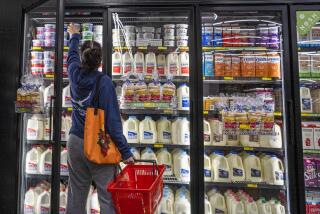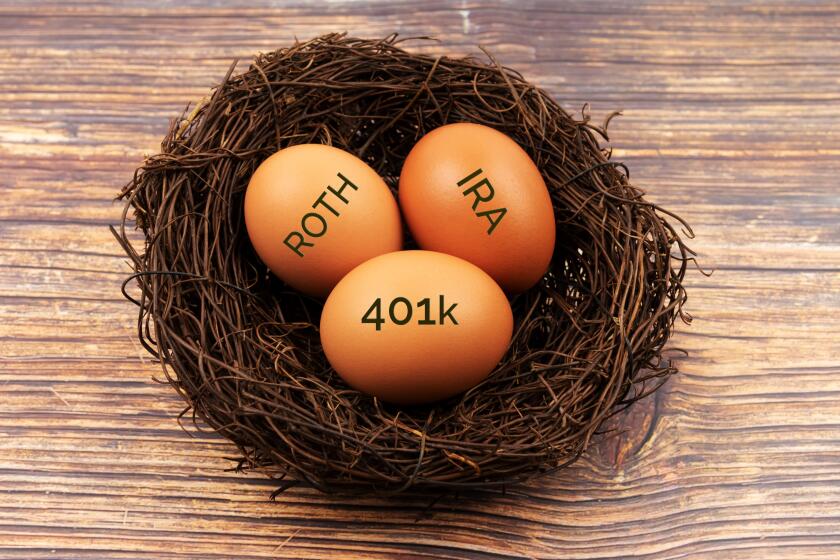Incomes Jump 0.8%, While Spending Rises Only Slightly
- Share via
WASHINGTON — Americans’ personal incomes shot up 0.8% in November, but spending rose only half as much, and analysts say it remained restrained as the holiday shopping season ended.
Incomes totaled $7.03 trillion at a seasonally adjusted annual rate, up from $6.97 trillion in October, the Commerce Department said Wednesday.
It was the biggest jump since incomes rose 1% in June 1996 and was slightly better than the 0.7% gain analysts had expected.
The 0.4% increase in spending, to a $5.59-trillion annualized rate, was less than the 0.5% economists had predicted, but it was in line with reports the holiday shopping season was not meeting many retailers’ expectations.
The combination of incomes and spending meant that Americans’ savings rate--savings as a percentage of disposable income--was 4% in November, up from 3.8% the previous month.
Many analysts believe consumer spending will remain moderate during 1998, but still act as an economic stimulus. Spending represents about two-thirds of the nation’s economic activity.
Cheryl Katz, an economist at Merrill Lynch & Co., estimated that fourth-quarter consumption rose between 2.5% and 3%, compared with a robust 5.6% in the previous three months.
“We look for consumer spending to rise at a sustainable 2.5% to 3% rate in 1998, versus an estimated 3.3% pace in 1997,” she said. “A moderation in consumer spending will keep the Federal Reserve [Board] from tightening next year” to keep the economy from overheating and fueling a burst of inflation.
But in November, higher employment and average weekly hours and hourly earnings contributed to the income gain.
A separate report from the Labor Department suggested the labor market remains tight in December. It said new claims for unemployment benefits fell by 13,000 last week to 307,000. Many analysts had expected only a 1,000 drop.
And the Conference Board said U.S. businesses stepped up their efforts to recruit new employees last month, pushing the group’s help-wanted index to 92 in November from 87 in October.
However, the four-week average for jobless claims, a less volatile gauge of employment conditions than the weekly figures, rose to 315,750 from 315,000 the previous week. That may be a sign that company layoffs are on the rise, according to economists at Chase Securities.
Spending on durable goods--usually big-ticket items such as cars and computers expected to last more than three years--rose 0.8% in November after falling 0.2% a month earlier. But spending on nondurable goods such as food and fuel and on services both edged up just 0.2%.
Private wages and salaries, the most closely watched component of income, shot up $43.1 billion after climbing $27.6 billion in October. Employment and average weekly hours and hourly earnings all increased.
Disposable income--income after taxes--rose 0.7%, up from 0.5% a month earlier, and the largest gain since a 0.9% increase in June 1996.
The income and spending percentages were not adjusted for inflation. When adjusted, disposable incomes rose 0.6% compared with a 0.4% increase in October. Spending was up 0.3%, the same as the previous month.
Economists, investors and Fed policymakers watch consumer spending because it accounts for roughly two-thirds of the nation’s output of goods and services. The November report also is one gauge of how much consumers spent at the beginning of the year’s holiday shopping season--a time when retailers can ring up as much as 40% of their annual profit.
So far this year, discounters and upscale department stores have fared best. And though sales aren’t stellar, most economists and retailers still shy away from calling them disappointing. J.C. Penney & Co. said holiday sales were below its expectation of a 1% to 3% increase from last year. Even so, “We have our fingers crossed,” company spokesman Duncan Muir said this week.
One force that may boost spending among homeowners--and help retailers’ bottom lines--is a drop in mortgage rates. The average rate on a 30-year, fixed mortgage plunged below 7%, to 6.99%, for the first time in more than two years this week, the Federal Home Loan Mortgage Co. said Wednesday. Falling rates over the last eight months have already sparked a refinancing boomlet that economists say may push overall consumer spending in 1998 by a quarter of a percentage point higher than earlier estimates.
(BEGIN TEXT OF INFOBOX / INFOGRAPHIC)
Personal Income
Seasonally adjusted annual rate, in trillions of dollers
Nov.; $7.03
(BEGIN TEXT OF INFOBOX / INFOGRAPHIC)
Personal Spending
Seasonally adjusted annual rate, in trillions of dollars
Nov.; $5.59
More to Read
Inside the business of entertainment
The Wide Shot brings you news, analysis and insights on everything from streaming wars to production — and what it all means for the future.
You may occasionally receive promotional content from the Los Angeles Times.










